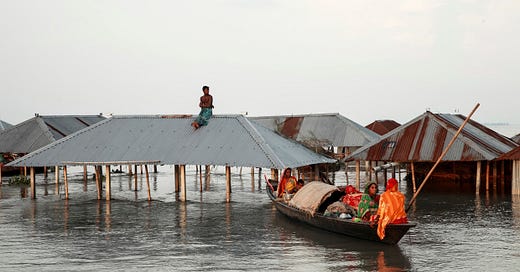Oh, we’re here again are we?
I feel like I’ve debunked this over and over again, but here we go.
A recent report on climate change and migration is claiming that 1 billion climate refugees are on the move, urging the UK to take action to prevent the far right from exploiting this issue. It also advocates for investment in climate adaptation in the Global South to prevent people from migrating to Europe.
There won’t be 1 billion climate refugees
Climate change will dramatically reshape patterns of migration. But the figure of 1 billion climate refugees is factually incorrect. While climate change does influence migration patterns, it doesn't necessarily lead to mass exoduses across borders. Instead, climate-linked migration is often internal and short distances. People often engage in seasonal or circular migration to secure their livelihoods, moving temporarily and returning home when conditions improve.
Predicting future patterns of climate mobility is extraordinarily difficult. The academic field studying this phenomenon is still in its infancy, and no reliable global predictions exist. Multiple factors—including future economic conditions and political stability —intersect with climate impacts, making simplistic numerical forecasts unreliable.
Investing in climate adaptation might not prevent migration
While investing in climate adaptation and resilience is crucial, assuming it will prevent migration to Europe is misguided. Climate adaptation may have little impact on migration; in some cases, it could even increase it. To understand this uncertainty, we need to consider people's vulnerability to the effects of climate change.
People exist on a spectrum of climate vulnerability. Currently, climate change drives human movement across this entire spectrum. Those in extreme danger flee to save their lives, while others in less severe—but still challenging—situations move to protect their livelihoods. Climate change can also trap people. As livelihoods are destroyed, some lose the resources needed to migrate and become trapped in dangerous locations.
Climate resilience projects aim to reduce people's vulnerability to climate impacts. However, even if people become less exposed, it doesn't guarantee they will stay put. Adaptation may change the conditions under which people move, allowing them to migrate with more safety, flexibility, or at different times.
Yes, governments like the UK's should invest in adaptation and make funds available to governments and organisations in the Global South to increase climate resilience. But they should not expect that these projects will prevent or slow climate-driven migration.
Innacurate claims are not helping
The authors claim this is all about stopping the rise of the far right. But circulating exaggerated or incorrect information about the scale of climate-driven migration is counterproductive. If we're genuinely concerned about the far right weaponizing this issue repeating myths (like the 1 billion figure) is one of the worst things to do. Misinformation can be exploited to stoke fear, sow division, and justify harsh policies.
When inflated figures like "1 billion climate refugees" are shared, they can create a sense of impending crisis that far right commentators can use to their advantage. This fear mongering distracts from the real challenges and undermines efforts to develop compassionate responses to climate-induced migration.
Accurate information is essential. By focusing on the data we actually have and acknowledging the complexity of climate-linked migration, we can prevent the manipulation of this issue by those seeking to incite fear or advance harmful agendas.



